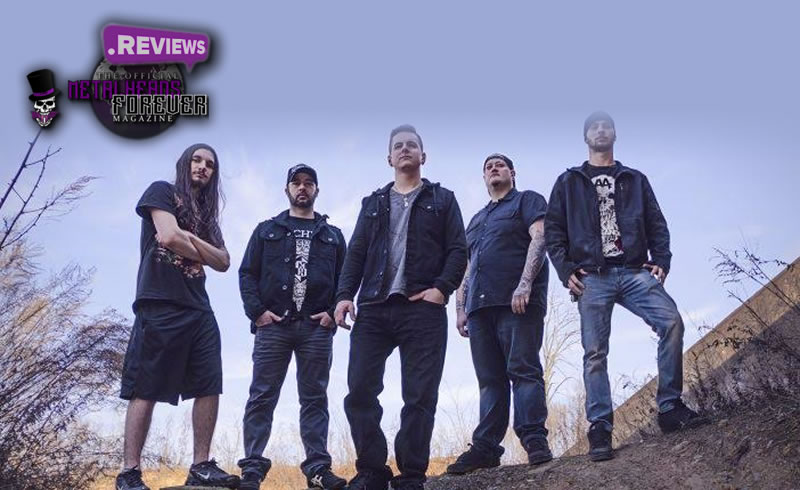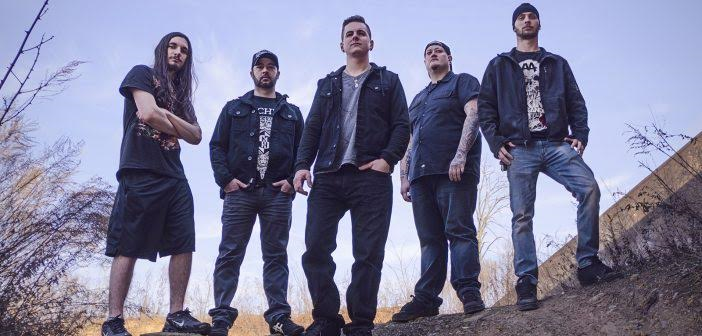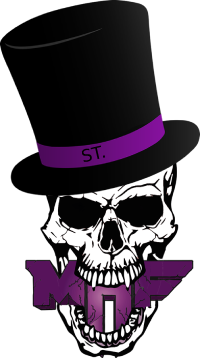Twelve Noon By Michael Aronovitz
The Faces We See In Our Shattered Reflections
I have constructed what is now an ongoing proposal that Eclipse Records is not just a “Deathcore” label, or even one that merely produces and distributes “New Metal.” That would be the definition of a conduit, and Eclipse is more like a canvas. Though I would admit that bands like Our Last Enemy, Saint Diablo, Cold Snap, A Breach of Silence, Despite, and Mindshift share the common signature of tight and razor sharp rhythm sections, it is clear that each project brings something new to the table, something altogether unique, and above all, multi-dimensional. Being that I was a professional metal club musician in the 80’s and currently teach English rhetoric at the college level, my standards for “multi-dimensional appeal” are not limited to tight rhythm sections, spectacular lead platform solos, and daring vocals, though I treasure the manner by which they are delivered by the extraordinary musicians currently recording under the Eclipse umbrella. I am additionally searching for metaphor, for dramatic precision, and a distinct literary thread that the given band would weave into the broadcloth of art and humanity, and Eclipse bands are consistent in their ability to live and breathe in both worlds, something I find magnificent.
To briefly digress, I see Our Last Enemy as interpreters of a modern day Renaissance similar to the way that Saint Diablo reinvents the lens of psycho-religiosity and spiritual awareness. Cold Snap cleverly articulates the paradox of media influence and conservative brutality, as much as A Breach of Silence offers a profound pathway to the human spirit, architected on the poetic level of a Whitman or Frost.
If you will allow a second digression, this brings me to the work of the greatest American author on record, the ground-breaking inventor of Modernism, Ernest Hemingway, and it is more than clear that Eclipse Records has made it a subtle yet powerful mission to provide us a number of bold innovators who would create aesthetic masterpieces reanimating and therefore redefining the influence of Hemingway’s dark, poetic vision. The band Despite explodes with the violence and glorified spectacle that Hemingway portrayed in his war scenes just as much as Mindshift illustrates a brilliant portrait reminiscent of Hemingway’s cold manifestations of boyhood dreams, biting realities, and harsh rites of passage. In terms of Ernest Hemingway’s fascination with the ebbs and flows of bodies of water, and more specifically the distorted reflections we might stare into during our given searches for identity, I have not seen a more striking modern example than the single, No Way Out, by one of Eclipse’s newest bands called Twelve Noon.
First off, these guys can play. Before getting into the literary comparisons, I come from a primary position of loving rock for the sake of rock, and while the press on this project says that they are “An American Alternative Metal Band” I want to make the broader statement here that regardless of “brand” or “label” or “genre,” this particular group is a rocker’s dream. If you grew up on The Who and graduated to Sound Garden (rest Chris Cornell’s soul), you’re going to love Michael Loew’s vocal. If you were raised listening to Aerosmith’s Joe Perry and found God in Van Halen, you’re going to dig Rob Heil’s guitar work. If you were one of the ones like me, who not only got off on Angus Young, but fucking LOVED his brother Malcolm’s chops, you’re going to want a tee shirt that says John Devlin on it, and if you could never get enough of Sabbath’s rhythm section, or Zeppelin’s or Purple’s for that matter, you are going to get hooked on watching Tim Clark work his bass in and out of Justin Runkel’s clever drum work all through the No Way Out video. Again and again and again.
I do not mean to infer that Twelve Noon is “throwback.” In fact, they are incredibly fresh, demonstrating the more current growl vocals and hummingbird sixteenth double bass drum licks all the modern deathcore and more commercial metal guys are throwing out there, almost like benchmarks, like a line in the sand, claiming, “Are you good enough to do these? Well, you’d fucking better be.”
The difference is that Twelve Noon uses these standards and other “metal tropes” if you will, not for the purpose of checking off boxes or making grades. They use the various techniques where they are appropriate, where they come as surprises, always themed in a pattern that plays into the idea that it was constructed for the greater good of the song. Twelve Noon is a team. They come off as a band, not a bunch of free agents, and that is their primary appeal once you take in how damned good they are in their given roles.
The funny thing is that their image is a strange one, weird optics, and if one looks at them without hearing the music it might seem that they come from different parts of the world. Loew has perfect short hair and that perfect cowboy jaw, like a Hollywood star wearing sunglasses, while Clark and Runkel look like they work for Harley Davidson. Devlin could live next door to you, while Heil is your partner in fantasy football and the clean-up hitter on your softball team. But the real funny thing (funny-ironic) is that it is clear they were born to play together, and it doesn’t take a genius to see how well they mesh once the song starts. Moreover, the track is a hit, and you don’t have to have a bunch of tunes from Octane to compare it to. Sometimes you just know. Twelve Noon makes it easy.
It is clear the band musically follows the vision of guitar extraordinaire Rob Heil. I have watched the video eleven times today, and come away from each performance in its entirety with a feeling of absolute joy. I think it’s the idea that he has that rare ability not only to help engineer a smash single, but float in and out of it through a kaleidoscope of techniques that are as diverse from each other as they are holistically true to the general theme. There is a finger picking intro, tasteful as hell, gripping at your heartstrings the way old time songs bring you back to some specific moment in your past that you measured yourself by. Effortlessly, that becomes a riff, into a call-to-arms lead, into a quickie-run, into the hard picking that backs the verse, into the tapping in the themed bridge during the growl vocal, into the speed-metal riff, into the half-chord lead mixture supporting the catchy chorus. Then, just when you thought it couldn’t get any better after verse and chorus number two respectively, there is the power chord transition where Runkel does his entertaining cross-cymbal crashes, the slow down to the uplifting wake-me-up-with-the-sunrise strumming (two measures), then the pull-off lead, the melodic chunk-a-chunk, the acrobatic lead, and back to the chorus of the decade.
Hell. If I was a guitar instructor, this song would be my demonstration for the parents at the spring festival showing that I was worthy. Like everyone, I have seen and heard those song/videos where the guitar player is just showing off tricks (The Freebird Syndrome…even though I still love that song), and this is not one of those ego-filled demonstrations. It is one of the most beautifully textured and engineered backbones to a song that I have ever seen. And the Van Halen bird-chirp tapping (really introduced in 1932 on the ukulele by Roy Smeck) is delivered with such a specific Heil appeal, that we can do nothing but smile right along with him and give a nod to the allusion.
Musically, there are other areas in here that add to the “wow” factor of Twelve Noon. While Loew is the stud on vocals, managing a broad range of tapestries and personalities, Clark is exceptional in his doubling work, playing it rough or tonal depending on the echo that best flavors the phrase. And Runkel reminds me of a very, very tight evolution of Deep Purple’s Ian Paice, hard and everything metal, but smooth on the fills like fine silk.
On literary grounds, this band is all about growth and hard rites of passage, the theme of Hemingway’s debut, In Our Time. In his collection of short stories, we are given a variety of tales and scenarios of attempted bravery by those too young to address the given circumstances. It is no small coincidence that lyrics in No Way Out mirror these things, with exclamations such as, “Here’s my anthem from the time I was young,” and “A change inside me ignites,” moving to “Turn the tables on the things I have done.” All this reflects tests of youth and the following transition to adulthood, and Hemingway fans will literally sit back with a satisfied smile when they hear, “Fighting the bull now. And grab it by the horns,” as the central vignettes in the book In Our Time are all about bullfighters, and whether they face their deaths bravely.
Instead of grabbing them by the horns, however, Hemingway has his performers get it “through his sword hand” and “through the belly” (83), and after the trials and tribulations in the bull ring, metaphorical and literal, Hemingway has his non-bullfighting lead character (Nick Adams) healing his own sorts of wounds at the Big Two-Hearted River, looking in the rushing water at his distorted reflection trying to figure out who he is and how he got there. The most striking part of this comparison between art forms and generations, however, remains both audible and visual, as Loew tries to “Re-enable what I have become,” only reversing it into the question, “Re-enable what have I become?” sharing the idea with Hemingway that we spend much of our time in a state of “static odyssey,” standing in place while we sort through our shattered self-images. Why else would Twelve Noon use the otherwise random effect of having the camera filming the band intermittently “shake” as if something was just dropped into river-water, creating this disturbed liquid mirror?
Twelve Noon is a worthwhile, legitimate, and talented rock band performing on a label with an established reputation for precision and excellence, statement and metaphor. No Way Out is a part of the canvas, an important thread in the broadcloth, a rich aesthetic, a guitar player’s golden template. But mostly, it works. Mostly, it moves us, and altogether, when everything is all said and done, it’s simply just one great fucking rock song. (Off the album Saints and Sinners, recently released by Eclipse Records.
Michael Aronovitz is a horror author who has published three novels, two collections, more than thirty short stories, and a number of horror and metal reviews. His first novel “Alice Walks” will come out in E-book form through Cemetery Dance Publications this summer. His latest novel “Phantom Effect” can be seen on Amazon here: http://tinyurl.com/jcg59wo
Michael Aronovitz / Metalheads Forever Magazine





